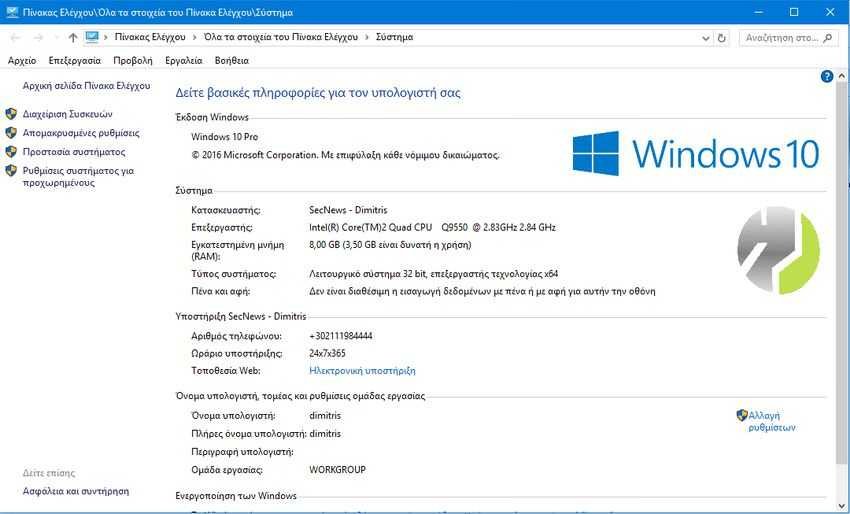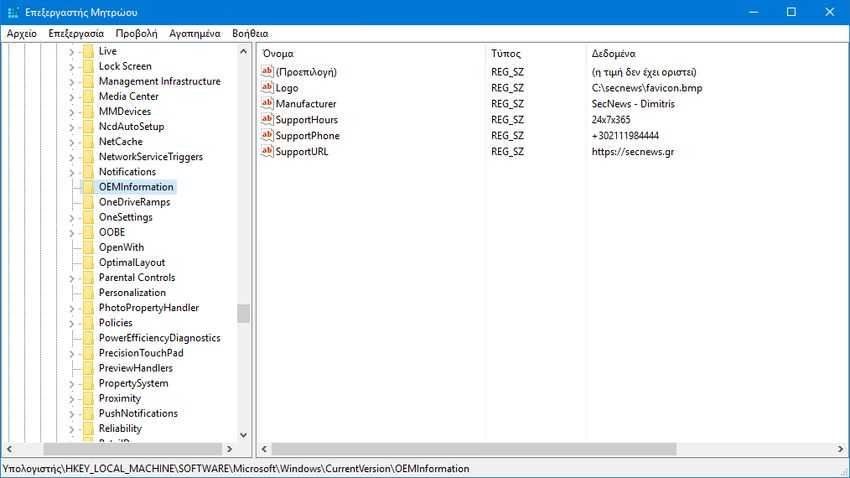If you bought your Windows computer from a reputable manufacturer, then you may see some information about it in the “System” tab. You can, if you want, change all of these data and identify yourself as the manufacturer of your computer, even providing additional information about yourself.

The "System" window in Windows has a lot of useful information about your computer, such as the model of your processor, the amount of installed μνήμης RAM, ποια έκδοση των Windows τρέχετε κλπ. Εάν χρησιμοποιείτε ένα έτοιμο επώνυμο υπολογιστή, το παράθυρο αυτό δείχνει επιπλέον πληροφορίες του κατασκευαστή, όπως το όνομα του κατασκευαστή, τον τηλεφωνικό αριθμό υποστήριξης, την ιστοσελίδα του, τις ώρες υποστήριξης, ακόμα και ένα λογότυπο του.
You can customize this information by modifying it or adding your own information. Kind of like being the builder of your system. Or if you want, like signing your machine (which might turn out to be a useful identifier in case thefts). All you have to do is tinker with the Windows registry. Let's see how.
First, to see the current status on the "System" tab, just click on start Windows (or press Win + X) and from there click on "System".

1. Now let's go change or add them. Open the Registry Editor. If you don't know how, then press the Win + R keys at the same time and type the word “regedit” in the window implementations that will appear. Click the OK button to open Registry Editor and say “Yes” if Windows asks for permission for Registry Editor to make changes to your computer.

2. In the Registry Editor, use the left side bar to navigate to the following key:
HKEY_LOCAL_MACHINE \ SOFTWARE \ Microsoft \ Windows \ CurrentVersion \ OEMInformation
3. If your computer already has manufacturer information, you will see multiple string values within the OEMInformation key. If your computer has no value, you should add them. You can add the following values:
- Manufacturer
- Support hours
- Support Phone
- SupportURL
- Logo
You do not have to add all the values. You can only add the ones you want to appear.
4. To add a value, right-click on the OEMInformation key in the right pane and select "Create" and then "String Value". Name the new value using one of the names from the list above, writing exactly as you see it and without spaces.

5. If the values already exist, then just double-click on each value you want to change to enter its properties tab and enter your own data in the "Value data" field and then click "OK" . You can either replace the information, add new ones of your own, or remove the ones you do not want to be seen. If your manufacturer's information already existed, then write it down before making any changes so that you can restore it if you wish.
As far as the logo is concerned, to add it, type the full path of the image you want to use. Eg:
C:\Secnews\favicon.bmp
For best results, use a small logo image, about 100 × 100 pixels and make sure it is in .bmp format, since it does not "read" .png and .jpg.
6. Once you have added the information you want, you can simply close Registry Editor. The changes will be saved automatically and made immediately, so you do not need to restart your computer. All the information you have entered should now appear in the "System" window.

If you ever want to catslowto make the changes, simply go back to the OEMInformation key and delete all values except the Default value. If you want to restore the information that was previously there, you will need to change each value and put the old one.





